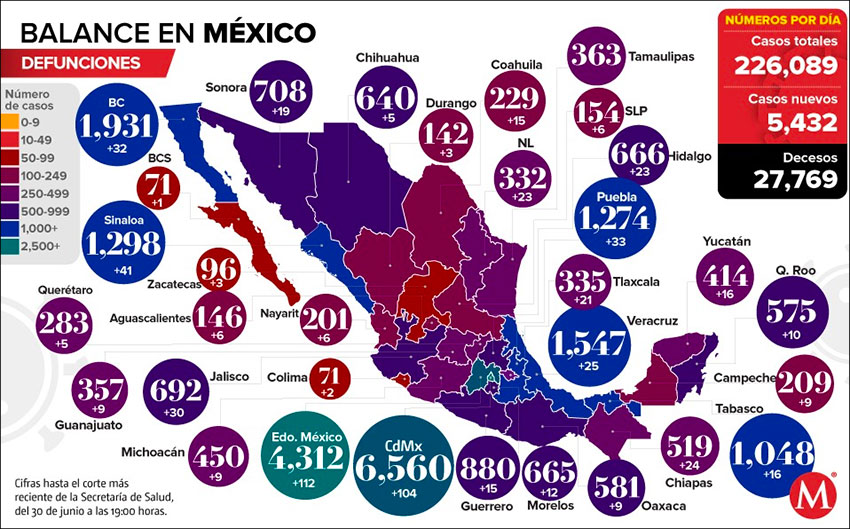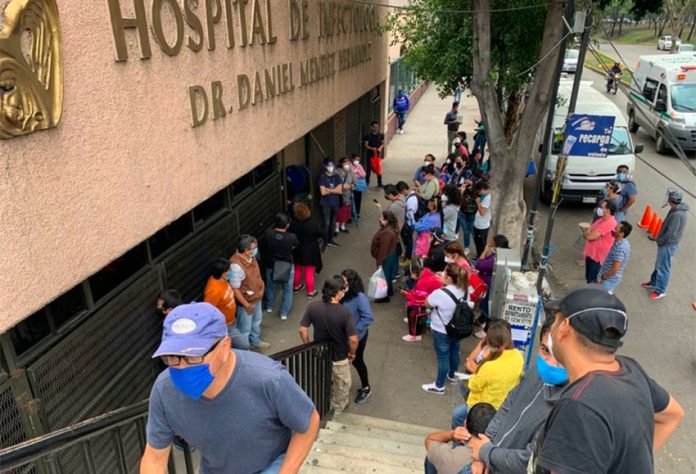The coronavirus pandemic is at its peak, Deputy Health Minister Hugo López-Gatell said Tuesday as more than 5,000 additional cases were added to Mexico’s tally.
“The number of cases presented daily continues to be very high, nobody should be confused by this. The epidemic is still active, in fact the epidemic is at its peak, let that be very clear,” López Obrador told reporters at the Health Ministry’s nightly coronavirus press briefing.
“There is still a large number of infections and hospitalizations that occur every day, and the number of deaths registered is approximately 600 per day. So the epidemic is still active, it hasn’t ended and it possibly won’t end before October,” he said.
Speaking at the president’s regular news conference earlier on Tuesday, López-Gatell offered a different assessment about how long the pandemic could last.
“How long in total will all this last? We can’t be sure but some scientific conjectures indicate that this could last several years, possibly two or three years,” he said.

“Given that reality, what the new normal implies is to live in a situation in which we can’t eliminate the risk completely, we can’t eliminate [the coronavirus] from the planet but we can … live … in a way that allows us to reduce the risk. In the reduction of this risk, there are changes [to our] daily life practices that allow us to reduce the probability of being infected,” López-Gatell said.
He stressed that people need to continue to keep their distance from each other and maintain good hand hygiene to help slow the spread of the virus.
The number of new Covid-19 cases reported by the Health Ministry declined for four consecutive days between last Friday and Monday but the downward trend came to an end on Tuesday.
Director of Epidemiology José Luis Alomía reported 5,432 additional cases, increasing the cumulative case tally to 226,089.
Mexico currently has the 11th highest case tally in the world, according to data compiled by Johns Hopkins University.
Alomía also reported 648 additional Covid-19 fatalities, lifting the official death toll to 27,769. Mexico currently has the seventh highest death toll in the world after the United States, Brazil, the United Kingdom, Italy, France and Spain.

In addition to the confirmed Covid-19 deaths, 2,197 fatalities are suspected of having been caused by the disease.
Of the confirmed cases, 23,782, or 10.5% of the total, are considered active, an increase of 393 compared to Monday. There are also 72,041 suspected cases across the country, while 581,580 people have now been tested.
Mexico City is the only entity with more than 3,000 active cases, according to official data, while neighboring México state has just over 2,000.
Seven other states have more than 1,000 active cases. They are Puebla, Guanajuato, Nuevo León, Yucatán, Coahuila, Tabasco and Veracruz.
Mexico City has the highest death toll in the country, with 6,560 confirmed Covid-19 fatalities, while Colima and Baja California Sur share the lowest, with 71 people confirmed to have lost their lives to the disease in both states.
With Mexico and the rest of the world bracing for a long pandemic – and no certainty about when or even if a coronavirus vaccine will be available – hospitals will face increased demand for their services for the foreseeable future.

In that context, Mexican Social Security Institute (IMSS) director Zoé Robledo told reporters Tuesday night that IMSS, one of the country’s largest health care providers, had increased its capacity to respond.
Robledo, who recently recovered from Covid-19 himself, said the number of designated Covid-19 hospitals has increased to 184 from 80.
IMSS hospitals have a total of 12,735 general care beds for coronavirus patients and 3,460 with ventilators, he said.
National data showed that 45% of all general care hospital beds set aside for coronavirus patients are currently occupied while 40% of those with ventilators are in use.
At 65%, Nayarit has the highest occupancy level in the country for general care beds, while Baja California has the highest occupancy level for beds with ventilators, with the same percentage currently in use.
Source: La Jornada (sp), El Financiero (sp), Milenio (sp), El Universal (sp)
